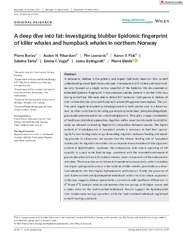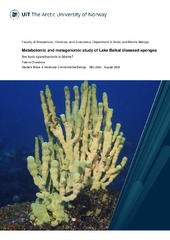Institutt for arktisk og marin biologi: Recent submissions
Now showing items 841-860 of 2086
-
A deep dive into fat: Investigating blubber lipidomic fingerprint of killer whales and humpback whales in northern Norway
(Journal article; Tidsskriftartikkel; Peer reviewed, 2021-05-01)In cetaceans, blubber is the primary and largest lipid body reservoir. Our current understanding about lipid stores and uses in cetaceans is still limited, and most studies only focused on a single narrow snapshot of the lipidome. We documented an extended lipidomic fingerprint in two cetacean species present in northern Norway during wintertime. We were able to detect 817 molecular lipid species ... -
Modeling the demography of species providing extended parental care: A capture–recapture multievent model with a case study on polar bears (Ursus maritimus)
(Journal article; Tidsskriftartikkel; Peer reviewed, 2021-03-10)<ol> <li>In species providing extended parental care, one or both parents care for altricial young over a period including more than one breeding season. We expect large parental investment and long-term dependency within family units to cause high variability in life trajectories among individuals with complex consequences at the population level. So far, models for estimating demographic ... -
Don't go chasing the ghosts of the past: habitat selection and site fidelity during calving in an Arctic ungulate
(Journal article; Tidsskriftartikkel; Peer reviewed, 2021-04-01)Predator avoidance and food availability are both factors known to influence habitat selection and site fidelity around calving in caribou and reindeer. Here, we assess habitat selection and site fidelity during the calving period in the solitary, Arctic Svalbard reindeer Rangifer tarandus platyrhynchus, which is subject to limited predation risk and human disturbance. In this largely predator-free ... -
First record of plastic debris in the stomach of a hooded seal pup from the Greenland Sea
(Journal article; Tidsskriftartikkel; Peer reviewed, 2021-04-14)Plastic debris is globally found around the world and the remote Arctic is no exception. Arctic true seals are sentinel species of marine pollution and represent the link between marine food webs and Arctic apex predators like polar bears and humans. With regard to true seals, ingested macroplastics have never been reported in an Arctic species. We harvested 10 harp seals Pagophilus groenlandicus ... -
Transport Barriers and the Retention of Calanus finmarchicus on the Lofoten Shelf in Early Spring
(Journal article; Tidsskriftartikkel; Peer reviewed, 2021-08-02)Large aggregations of the copepod Calanus finmarchicus occur each spring in the shelf-slope-oceanic regions off the Lofoten-Vesterålen Islands where productive fisheries have traditionally supported local economies. The retention and off-shelf transport of populations of C. finmarchicus populations were studied by analyzing ocean color remote sensing, satellite altimetry data, and Lagrangian Coherent ... -
Swimming performance of subarctic Calanus spp. facing downward currents
(Journal article; Tidsskriftartikkel; Peer reviewed, 2021-04-29)Calanoid copepods dominate mesozooplankton communities in temperate and Nordic seas. The ability of copepods to remain and feed in productive surface waters depends on their ability to overcome downward flows. In this study, we assessed the swimming performance of subarctic Calanus spp. and tested how the copepods can retain their vertical position in a representative range of downward currents ... -
Assessing a nationwide policy reform toward community-based conservation of biological diversity and ecosystem services in the Alpine North
(Journal article; Tidsskriftartikkel; Peer reviewed, 2021-05-05)Many attempts have been made worldwide to implement community-based conservation to gain a more inclusive protection of biological diversity and ecosystem services. In a recent national reform, the management of protected areas was devolved from the Norwegian government to local conservation boards. The main goals were to reduce local resistance toward conservation and ameliorate threats to biodiversity. ... -
Sea trout Salmo trutta in the subarctic: home-bound but large variation in migratory behaviour between and within populations
(Journal article; Tidsskriftartikkel; Peer reviewed, 2021-06-28)Anadromous brown trout (sea trout), Salmo trutta, is currently in decline throughout its range, largely due to anthropogenic stressors in freshwater and marine habitats. Acoustic telmetry was utilized to study the marine migration of sea trout post-smolts from three populations in a relatively pristine subarctic fjord system. While at sea, the sea trout spent a substantial part of their time close ... -
Multiple configurations and fluctuating trophic control in the Barents Sea food-web
(Journal article; Tidsskriftartikkel; Peer reviewed, 2021-07-09)The Barents Sea is a subarctic shelf sea which has experienced major changes during the past decades. From ecological time-series, three different food-web configurations, reflecting successive shifts of dominance of pelagic fish, demersal fish, and zooplankton, as well as varying trophic control have been identified in the last decades. This covers a relatively short time-period as available ... -
Transmission across the water-air interface: resolving the impact of multiple interactions at the sea surface
(Journal article; Tidsskriftartikkel; Peer reviewed, 2021-01-07)A series of Monte Carlo and HydroLight radiative transfer simulations are used to demonstrate that the traditional form of the Fresnel transmission across the water-air interface is accurate. This contradicts assertions to the contrary in a recent paper [Opt. Express 25, 27086 (2017) [CrossRef] ] that suggested that the impact of multiple surface interactions had previously been ignored and that ... -
Analysis of composition, morphology, and biosynthesis of cuticular wax in wild type bilberry (Vaccinium myrtillus L.) and its glossy mutant
(Journal article; Tidsskriftartikkel; Peer reviewed, 2021-03-09)In this study, cuticular wax load, its chemical composition, and biosynthesis, was studied during development of wild type (WT) bilberry fruit and its natural glossy type (GT) mutant. GT fruit cuticular wax load was comparable with WT fruits. In both, the proportion of triterpenoids decreased during fruit development concomitant with increasing proportions of total aliphatic compounds. In GT fruit, ... -
Seasonal Variability in the Zooplankton Community Structure in a Sub-Arctic Fjord as Revealed by Morphological and Molecular Approaches
(Journal article; Tidsskriftartikkel; Peer reviewed, 2021-08-04)Phyto- and zooplankton in Arctic and sub-Arctic seas show very strong seasonal changes in diversity and biomass. Here we document the seasonal variability in the mesozooplankton community structure in a sub-Arctic fjord in Northern Norway based on monthly sampling between November 2018 and February 2020. We combined traditional morphological zooplankton identification with DNA metabarcoding of a 313 ... -
All-sky camera system providing high temporal resolution annual time series of irradiance in the arctic
(Journal article; Tidsskriftartikkel; Peer reviewed, 2021-07-23)The ArcLight observatory provides hourly continuous time series of light regime data (intensity, spectral composition, and photoperiod) from the Arctic, Svalbard at 79° N. Until now, no complete annual time series of biologically relevant light has been provided from the high Arctic due to insufficient sensitivity of commercial light sensors during the Polar Night. We describe a camera system providing ... -
Pelagic organisms avoid white, blue, and red artificial light from scientific instruments
(Journal article; Tidsskriftartikkel; Peer reviewed, 2021-07-22)In situ observations of pelagic fish and zooplankton with optical instruments usually rely on external light sources. However, artificial light may attract or repulse marine organisms, which results in biased measurements. It is often assumed that most pelagic organisms do not perceive the red part of the visible spectrum and that red light can be used for underwater optical measurements of biological ... -
Hiding in plain sight - Euplokamis dunlapae (Ctenophora) in Norwegian waters
(Journal article; Tidsskriftartikkel; Peer reviewed, 2021-03-17)Cydippid ctenophores of genus Euplokamis have been rarely reported from the north-east Atlantic in the scientific literature. The conspicuous lack of previous records is likely attributable to methodological constraints detrimental to sampling ctenophores, including the use of plankton nets and preservation of samples as well as poor identification literature and a lack of taxonomic expertise on ... -
Two hundred years of zooplankton vertical migration research
(Journal article; Tidsskriftartikkel; Peer reviewed, 2021-05-04)Vertical migration is a geographically and taxonomically widespread behaviour among zooplankton that spans across diel and seasonal timescales. The shorter-term diel vertical migration (DVM) has a periodicity of up to 1 day and was first described by the French naturalist Georges Cuvier in 1817. In 1888, the German marine biologist Carl Chun described the longer-term seasonal vertical migration ... -
A distributed time-lapse camera network to track vegetation phenology with high temporal detail and at varying scales
(Journal article; Tidsskriftartikkel; Peer reviewed, 2021-07-29)Near-surface remote sensing techniques are essential monitoring tools to provide spatial and temporal resolutions beyond the capabilities of orbital methods. This high level of detail is especially helpful to monitor specific plant communities and to accurately time the phenological stages of vegetation – which satellites can miss by days or weeks in frequently clouded areas such as the Arctic. In ... -
Fat storage influences fasting endurance more than body size in an ungulate
(Journal article; Tidsskriftartikkel; Peer reviewed, 2021-04-26)<ol> <li>The fasting endurance hypothesis (FEH) predicts strong selection for large body size in mammals living in environments where food supply is interrupted over prolonged periods of time. The Arctic is a highly seasonal and food restricted environment, but contrary to predictions from the FEH, empirical evidence shows that Arctic mammals are often smaller than their temperate conspecifics. ... -
Novel methanotrophic community assemblages in a terrestrial methane seep in Svalbard
(Master thesis; Mastergradsoppgave, 2020-08-14)Recent studies have concluded that groundwater driven methane escape through open system pingos is an important greenhouse gas source in the vulnerable high Arctic. In wetlands and marine sediments, large quantities of methane are consumed by methane oxidizing bacteria (MOB) and ANaerobic MEthanotrophic (ANME) archaea, preventing its release to the atmosphere. The methanotrophic capacity of open ... -
Metabolomic and metagenomic study of Lake Baikal diseased sponges
(Master thesis; Mastergradsoppgave, 2020-08-15)Widespread mortality and disease are recognized as growing problems in benthic marine coral and sponge communities across the globe and despite being extensively studied, in most cases the etiology of disease remains unknown. Since 2011, sponge communities in freshwater Lake Baikal, Siberia, Russia have been affected by an unknown agent of disease, which has been causing an array of physical disease ...


 English
English norsk
norsk


















